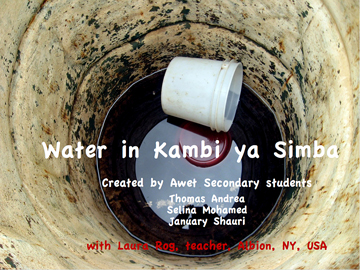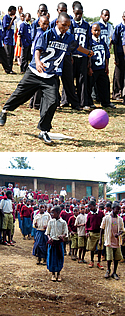Last year, the Bear Creek students wanted their funds to support a mural painting project on the outside walls at the primary school. No one in the village, of any age, had seen a wall mural, but a young artist from Moshi (a five-hour drive away) helped the students paint colorful maps of Africa and diagrams of human digestion and reproduction, topics they had studied in class. This year, the Colorado fourth graders raised money for new wooden desks and school uniforms.
“So very many blessings, “ the head teacher at the village primary school said when students appeared this August wearing their new uniforms.
Cultural exchange

Five American teachers, traveling separately, have visited Kambi ya Simba, hand delivering the “In Our Village” books their own students created. In one informal project, students in Albion, New York and Kambi ya Simba exchanged photographs and stories that described how water “happened” and was used in their respective communities. The Albion students marveled at how Kambi ya Simba youth, some as young as four, walked with large water jugs balanced on their head. The Kambi ya Simba youth marveled at a creature comfort we take for granted: the toilet.
However, the largest cultural exchange by far occurred this summer, when 14 students, 3 teachers, and 3 parents from Cathedral High School in Indianapolis visited the village. The students had spent a full semester studying Tanzania—a one-of-kind course, developed by their teacher, Liz Browning, and inspired by In Our Village. As part of the class, each student investigated a different aspect of Tanzania, then researched their own school to produce a photo essay book to share with students in Kambi ya Simba.
“Early in the course, we’d joke, wouldn’t it be fun to go to Africa and meet these kids,” Cathedral senior Drew recalled. “Then one day Ms. Browning came in and said, ‘How would you like to go to Tanzania?’ We couldn’t believe it.”
Once there, the Indianapolis students reached out to orphans and street children in Moshi, Tanzania. Then they made the five-hour trip to Kambi ya Simba, traveling in two successive groups so that they wouldn’t overwhelm the village’s largely nonexistent infrastructure. The village schools were on their June (winter) break, but the Cathedral students had come with plans of their own. They had gathered from friends and their school every piece of sporting equipment and uniforms worthy of donation—along with full sets of algebra and world history textbooks. [Teacher Liz Browning notes: "We each brought two large suitcases and one large carry-on. Our personal things could have easily fit in one bag. The rest contained: two textbooks (each weighed 5 lbs--I actually weighed them; mosquito nets; lots of candy (to distribute to the children); deflated soccer balls; soccer pumps; small toys (Beanie Babies and Matchbox cars were the hugest hit!); school supplies--paper, pencils, crayons, glue, scissors: kick ball bases; soccer jerseys for various leagues; a set of soccer jerseys from our high school team; a set of football jerseys from our state championship football team; lots and lots of clothes."]
In Kambi ya Simba, teachers spread the word that there would be a “field day” when the American visitors arrived.
The secondary school students welcomed their American peers with songs, speeches, and a lunch of rice and beans. The Cathedral high school students then pulled out bases and kickballs, nets and volleyballs. Explaining the rules of kickball proved challenging. But when the games moved to a soccer field (an expanse of dry grass without lines), the play became fluid. “We sorted ourselves into mixed teams and I got to play goalie,” Drew said. “Being up in the mountain, with kids who absolutely loved soccer but had little equipment, who played as much for the joy of it as to win, it was indescribable.”
When the bus carrying the second group of Cathedral students pulled up to the primary school the next day, a sea of children immediately surrounded it. Allie, a senior, wrote in her journal:
700 children singing beautifully greeted us. I choked back tears as I exited the bus, only to find 20 children swarming around me just hoping to touch me. I felt like some sort of celebrity, but I wanted to be the one thanking and appreciating them. Their life of bravery and hardship is so remarkable. Andrew [a classmate] said, ‘The first 30 seconds alone made the 5 hour drive worth it.’ The singing and dancing continued for 30 more minutes and words simply don’t do it justice. Thank god we recorded it.
After such stardom, I felt a bit awkward interacting…that lasted about 2 seconds. I found a pink bunny toy with wheels and had 50 new friends. As I kneeled down they would touch my hair and face in amazement. I returned the gesture, mostly because I didn’t know what else to do. We donated balls, candy, clothes, books, and I knitted 2 hats on the ride there. Nothing would have been enough, yet the children screamed in delight. I quickly learned that I actually knew more Swahili than they knew English, and that’s saying something. We giggled trying to communicate but they just really wanted to breathe my air. I spent the next 2 hours teaching them ‘Ring around the Rosie,’ ‘Heads, shoulders, knees, and toes,’ and giving them piggyback rides or just swinging them around. I could have stayed all week. Today changed my life.
Sharing blessings
Against the large sweep of globalization, the Kambi ya Simba story is one of small wonders. Eighteen-year-old Allie remembers fetching water from a pump and striking up a conversation with a girl who was also collecting water, both reaching hard to bridge the language divide. The girl asked Allie how old she was, Allie asked her to guess, and the girl said “thirty-six.” Allie asked the girl her age, guessing she was around twelve, and the girl answered “eighteen.” Two young women, joined in age but separated by inequalities as vast as the globe. “I knew then,” said Allie, “I would return to Africa and share what I had.”
Awet Secondary School students who receive scholarship support from In Our Village spend a week helping out and teaching at the primary school. Some are now entering teaching college, wanting to become teachers themselves. When I opened my email the other day, there was a message from Reginald, one of a handful of Awet graduates who keep in touch: “Madam! Currently l'am at Tabora teachers college undergoing two years of diploma course in human psychology, lCT, History, & English language with literature as well. I [want to] pass knowledge to children coming up. Madam! It’s not only that l'am after permanent employment but also l h've a dream to h've my own school one day.”
Reginald ends his email, “To my friends in America, may they stay blessed.”
<<BACK 1 | 2 |



